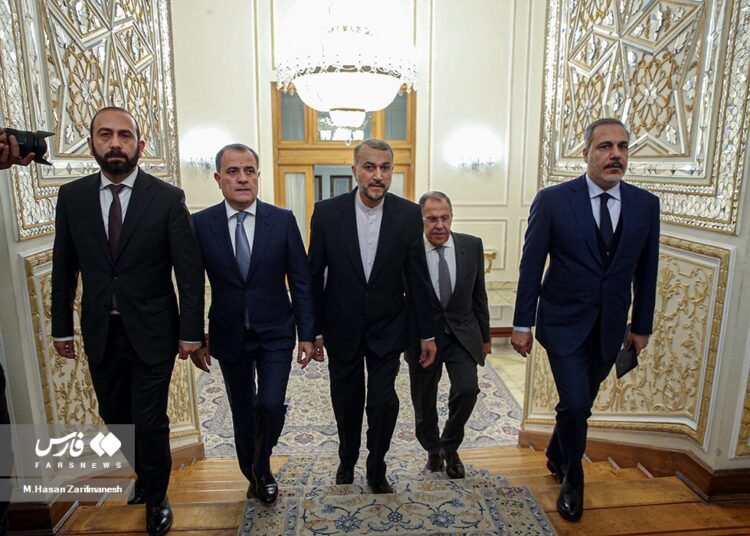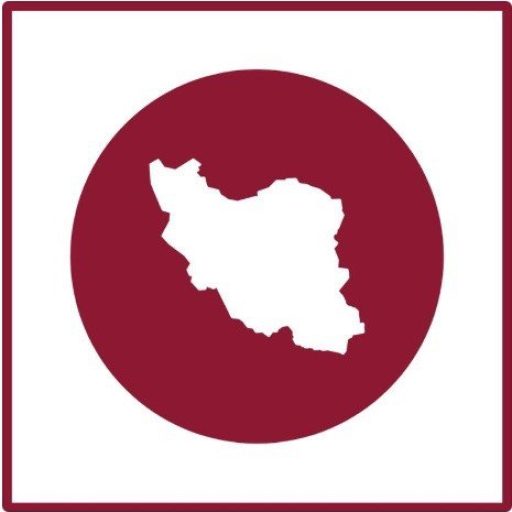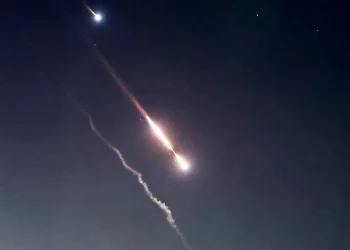On this day, October 23, Iran assumes a crucial role as it welcomes foreign ministers from Russia, Turkey, Azerbaijan, and Armenia in a meeting known as the 3+3 format. Notably, Georgia, another traditional participant of this format, is absent from this gathering in Tehran.
Encompassing three countries from the South Caucasus – Azerbaijan, Armenia, and Georgia – and three influential Caucasian neighbors, namely Iran, Russia, and Turkey, the 3+3 format is seen as a key regional platform for the South Caucasus. Provided that it attains a suitable mechanism for implementation, this would mark a significant stride toward resolving the region’s issues and fostering the economic prosperity of the South Caucasus.
The meeting currently underway in Tehran is the second within the parameters of the 3+3 format, following the inaugural assembly of deputy foreign ministers in Moscow last year, another forum which Georgia chose not to attend.
In the viewpoint of several experts, tapping into the potential of the 3+3 format could catalyze the formation of a collective security architecture in the South Caucasus and breathe life into the latent economic potential of the region.
Expert analysis suggests that the security blueprints of the South Caucasus rest on two primary pillars: geopolitics and geoeconomics. On the geopolitical front, the Karabakh crisis looms large, while geoeconomically, the contest for transit and energy corridors is paramount. Viewing it from this perspective, the resolution of the Karabakh crisis may pave the way for a groundbreaking initiative aimed at harnessing the economic potential of the region for collective benefit.
Despite the Karabakh issue ostensibly being resolved with Armenia and various regional and international actors acknowledging Azerbaijan’s sovereignty over the Karabakh region, there still remain elements in the region that induce mistrust, deviation, and potential tension around the Karabakh topic.
The ethno-historical underpinnings of the Karabakh conflict, coupled with the involvement of external actors vying for a piece of the geopolitical pie of the South Caucasus, are ongoing factors that stir tension. This layered competition and ever-present regional security apprehensions stand as further catalysts for exerting the influence by elements contributing to the tension.
The current dynamic of the region showcases an almost palpable clash of interests among all players. Historical hostilities between Azerbaijan and Armenia, Russia and Georgia, plus Turkey and Armenia, along with rivalries between Russia and Turkey, perceived threats between Azerbaijan and Iran, and competition between Iran and Turkey, all shape the intricate patterns of alliances and rivalries in this region.
Further, an examination of the behavioral motifs of the South Caucasus republics and their neighboring countries reveals that inter-regional dynamics have been predominantly molded by ethnic tensions and separatism. In light of this, countries in conflict have shown a predilection for engaging with extra-regional partners to secure further foreign policy resources. As a result, the security and political narratives of the Caucasus region have assumed a markedly non-native character and displayed extra-regional dimensions, a paradigm well illustrated in the recent Karabakh crisis, where both the United States and France found reltive room for involvement.
However, the activation of the 3+3 format could serve as the bedrock of the region’s political and security arrangements. It could foster a non-militarized and more secure regional landscape, aiding in the realization of economic plans and spurring development within the member countries of the region.
The convening of a meeting in Tehran at the level of foreign ministers underscores the presence of shared concerns that necessitate the delineation of common interests. Should the Tehran meeting successfully seize this opportunity to establish an institutional arrangement that ensures the continuation of the 3+3 format, it could signify substantial progress in the political and security convergence of the region.
Azerbaijan is pursuing a multifaceted, balanced, and interest-oriented policy that caters to the national needs and the requirements of surrounding powers. Such a strategic model could potentially empower Armenia in enhancing its stance within the South Caucasus.
Previously, Russia had viewed Azerbaijan as a rival within the European energy market. However, it appears that Moscow and Baku have arrived at a cooperative understanding, rendering even the crisis in Ukraine and a surge in Azerbaijan’s exports to Europe insufficient to stir discord in their bilateral relations.
Russia is endeavoring to transform its areas of competition with Turkey into zones of cooperation and shared interests, clearly evident in its proposition for Turkey to evolve into a significant energy hub.
One of the key regional challenges currently is the contest between Iran and Turkey. Iran harbors security apprehensions concerning Turkey’s plans with regard to geopolitics and geo-culture. The initial point of contention between Iran and Turkey pertains to the strategic objectives of the two nations. As per major documents outlining the development visions of Iran and Turkey, both countries aspire to emerge as preeminent regional powers. The race to secure a superior transit position forms one of the arenas where these two countries compete.
However, an issue of concern and potential threat for Iran lies in Ankara’s intent to expand, activate, and leverage Turkey’s strategic depth in the Caucasus. This plan, based on stirring ethnic passions and fault lines in the region, fuels Iran’s security anxieties.
Ankara’s longstanding ties with the West also pose Ankara as a proxy for the West in political and security facets in the region, a matter of constant concern for Iran. Interestingly, Russia does not openly voice apprehensions regarding Turkey’s ties and commitments toward the West and the US.
Nevertheless, given the current conditions in the region and worldwide, issues are emerging that could potentially propel the alignment of interests among the members of the 3+3 format, specifically pertaining to South Caucasus matters. A strategy anchored in maintaining security stability in the South Caucasus and promoting the region’s economic prosperity could be the collective ambition of the format’s members. Even under these circumstances, Georgia’s non-participation in the Tehran gathering or potential future meetings is unlikely to obstruct this process.
Drawing upon the experiences of the past three decades, Iran is well-positioned to play an active role in shaping the evolution of the 3+3 format. A successful regional model necessitates symbiotic relations with all regional countries. In the recent crisis, Iran employed this strategic model toward Azerbaijan and Armenia. This model could be extended to encapsulate Russia and Georgia as well. The relationship between Iran and Turkey also holds the potential for a mutually beneficial arrangement.
Iran can offer bilateral, trilateral, and quadrilateral economic, political, and security plans, alongside its ongoing efforts to cement regional order, in order to harness the region’s geo-economic prospects.
Broadly speaking, diplomatic finesse is paramount in addressing Iran’s issues in the Caucasus. It must be recognized that the meeting currently underway in Tehran is indeed emblematic of such diplomatic craftsmanship.






